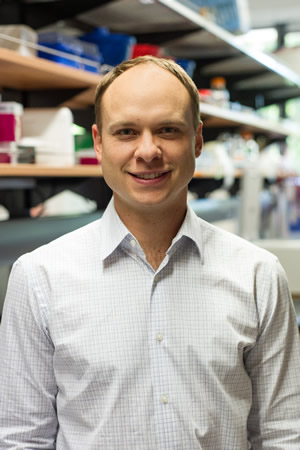By Olivia S. Rissland
 An Assistant Professor at Boise State University, Dr. Eric Hayden has long been fascinated by ribozymes and RNA evolution. As he put it, “evolution is the hallmark of life that separates biology from chemistry.” He continued, “my first scientific passion was trying to understand the origin of life. RNA played a central role here, and so studying RNA evolution is therefore critical to understanding why we exist, and how we came to be.”
An Assistant Professor at Boise State University, Dr. Eric Hayden has long been fascinated by ribozymes and RNA evolution. As he put it, “evolution is the hallmark of life that separates biology from chemistry.” He continued, “my first scientific passion was trying to understand the origin of life. RNA played a central role here, and so studying RNA evolution is therefore critical to understanding why we exist, and how we came to be.”
During his Ph.D. with Dr. Niles Lehman (at Portland State University), Dr. Hayden focused on one half of this puzzle—ribozymes—and engineered four RNA sequences that could self-assemble into a catalytic structure. In his postdoctoral work with Dr. Andreas Wagner (University of Zurich), Dr. Hayden transitioned to studying RNA evolution through high-throughput analysis of RNA sequence and function. During a second post-doctoral fellowship at Stanford University with Dr. Christina Smolke, Dr. Hayden pursued the application of laboratory evolved RNA molecules to control gene expression for bioengineering purposes. Dr. Hayden then started his own independent position in 2013, where he continues to study RNA evolution and bioengineering.
One project that Dr. Hayden is especially excited about investigates the fitness landscapes between two ribozyme functions. “Some RNA sequences, termed ‘intersection sequences, can catalyze both reactions, which requires that they can form very different structures with different active sites.” He explained, “we find that in this genotype space, there are many pathways for evolution to discover functions, and therefore innovation may become likely.” To investigate these areas, his lab uses experimental and computational approaches—“we are combining experimental data with computer simulations so that we can make movies of populations meandering between functions, and visualize this process.”
“Studying RNA evolution is critical to understanding why we exist, and how we came to be”
Another emphasis in his lab is trying to engineer biology, and, naturally, RNA is an important part of this direction. He explained, “I’ve always felt a strength of bioengineering is the potential to develop systems that improve over time or respond to environmental stimuli.” As production of high-value chemicals becomes biologically based, he continued, “small improvements to the robustness of our engineered systems to evolutionary and environmental changes will be critical for scaling efforts. I’m excited by the prospect that RNA evolution will have a role in this field as well.”
For Dr. Hayden, his biggest scientific hurdle came in transitioning from a post-doctoral researcher to an Assistant Professor. He found that “the hardest part was just getting a faculty interview—it’s so competitive.” He added, “surrounding myself with supportive people helped a lot, and I just didn’t give up. I owe a lot to my mentors who gave me opportunities and time.”
Now that he has his own group, he finds mentoring to be a new, yet exciting, challenge. “It is important to me that my lab supports people with very different backgrounds and personalities, and that I help them define and achieve their dreams“. Dr. Hayden has two key pieces of advice for trainees. First, find an environment that provides freedom but that offers support when you need it. Second, —and this piece of advice comes from Francis Crick —be sensible and don’t be swayed too much by negative arguments. “If at all possible, try the experiment and see what turns up.”
Dr. Hayden’s favorite RNA is the Azoarcus Group I intron—“second place is not even close!” Although he is not on social media, his group’s website can be found here.
